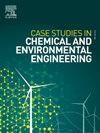Double-xerogel network composite zeolite granules targeting dual-functional fertilizers
Q1 Environmental Science
Case Studies in Chemical and Environmental Engineering
Pub Date : 2025-06-26
DOI:10.1016/j.cscee.2025.101253
引用次数: 0
Abstract
Food security remains a global challenge due to rapid population growth, intensive agricultural practices, and freshwater scarcity. This study presents the development of dual-functional composite granules combining sodium alginate (SA), gelatin, GIS-type zeolite, and CuO/ZnO nanorods for enhanced water retention and controlled micronutrient release. The GIS-type zeolite exhibited high water adsorption capacity (0.75 g H2O/g), while the incorporation of gelatin significantly increased the swelling ratio from 0.6 to 1.7, improving water retention and soil conditioning. CuO and ZnO nanorods embedded within the composite granules facilitated the controlled release of copper and zinc ions under acidic conditions (pH 4). The release of Cu2+ followed super case II transport (n = 0.98–1.10), while Zn2+ release followed an erosion-driven Weibull model. Water retention in soil increased by 20 % with gelatin-based granules after 7 days, and the water holding capacity of soil improved by 15 %–20 %. The composite granules demonstrated excellent mechanical stability, with a compressive stress of 1.5–5.5 MPa. This dual-functional system offers a sustainable approach to enhancing soil fertility and addressing micronutrient deficiencies while improving water retention in agricultural soils.

针对双功能肥料的双干凝胶网络复合沸石颗粒
由于人口快速增长、集约化农业实践和淡水短缺,粮食安全仍然是一项全球性挑战。本文研究了海藻酸钠(SA)、明胶、gis型沸石和氧化铜/氧化锌纳米棒的双功能复合颗粒的开发,以增强水潴留和控制微量营养素的释放。gis型沸石具有较高的水吸附能力(0.75 g H2O/g),而明胶的加入显著提高了沸石的溶胀比,从0.6提高到1.7,改善了保水和土壤调节。在酸性条件下(pH = 4),复合颗粒内嵌CuO和ZnO纳米棒有利于铜和锌离子的可控释放。Cu2+的释放遵循超级案例II迁移(n = 0.98 ~ 1.10), Zn2+的释放遵循侵蚀驱动的Weibull模型。添加明胶基颗粒7 d后,土壤保水能力提高20%,土壤持水量提高15% ~ 20%。复合颗粒具有优异的机械稳定性,压应力为1.5 ~ 5.5 MPa。这种双重功能系统提供了一种可持续的方法来提高土壤肥力和解决微量营养素缺乏问题,同时改善农业土壤的保水能力。
本文章由计算机程序翻译,如有差异,请以英文原文为准。
求助全文
约1分钟内获得全文
求助全文
来源期刊

Case Studies in Chemical and Environmental Engineering
Engineering-Engineering (miscellaneous)
CiteScore
9.20
自引率
0.00%
发文量
103
审稿时长
40 days
 求助内容:
求助内容: 应助结果提醒方式:
应助结果提醒方式:


